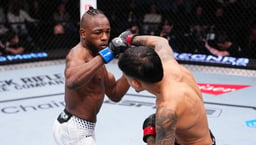
Issue 044
December 2008
The MMA world is full of larger-than-life personalities, characters who draw much attention to themselves with their antics and outbursts. At completely the other end of the scale is legendary ex-fighter and trainer Matt Hume, one of the most modest and unassuming gentlemen in the game.
A lifelong martial artist, Hume is in much demand as a trainer. Big name fighters from across the world travel to his Washington gym to refine their technique, work out game plans and generally benefit from his wisdom. Matt lists some of the fighters who have made their way to his gym, AMC Pankration: “Rich Franklin, Hayato Sakurai, Spencer Fisher, Jens Pulver – we’ve got a whole bunch of fighters you’ve never even heard of working with us.”
The man who took Josh Barnett from an obese teenager to a UFC world champion isn’t just a trainer though. One of the first Americans to regularly fight in Japan in the early nineties, he established his reputation as a versatile and technical fighter in the Pancrase organisation, and was later a competitor in the inaugural Abu Dhabi Combat Club (ADCC) Submission Wrestling World Championships.
“I started boxing when I was four years old and I boxed most of my life. Then when I was twelve I started wrestling on my junior high school wrestling team – I kept going through high school and college. I did karate and kickboxing from the time I was a little kid, and when full-contact karate got popular in the seventies I was doing that. Maurice Smith was the PKA (Professional Karate Association) champion and his trainer had a gym called AMC kickboxing. I had developed my own pankration group in college. I graduated and hooked up with him and started fighting and got involved with the kickboxing.”
As was the case with many early mixed martial artists, Hume was required to blend together his own knowledge of fighting systems to develop a style suitable for MMA. The title of his style, pankration, it is a reference to the Ancient Greek form of all-in fighting. “The Ancient Greek sport of pankration was the first to combine wrestling and boxing and so I gave credit back to that, but I never had anyone that taught me pankration. I did so many different martial arts, but in karate you weren’t allowed to take it to the ground, and in the wrestling gym you weren’t allowed to punch people – but in my backyard you could do anything! When we sparred, that was pankration – it would become known as ‘no holds barred’, and later ‘mixed martial arts’.”
With a lifelong background in the combative arts, Hume is of the opinion that “being a martial artist isn’t just being a fighter. It’s a lifestyle a person has to develop.” Hume has been around the block long enough that he doesn’t need to chase awards or titles, and will only train fighters he feels are worth working with. “I don’t just train people to win a fight. I train them to be the best martial artist they can be, which will give them the best chance of becoming a champion. A lot of guys when they come to me, their goal is that they want to win their next fight – but they need to learn what being a martial artist is, and when they develop that mentality they’re on the path to becoming a much better fighter. Honestly, I feel it’s a waste of time to train someone just for a fight, because they’re going to win and then go off, which is a very selfish thing and a waste of my time.”
When not working with fighters’ at his gym, Hume can often be found in Japan, where he has been actively involved with promotions such as Pride, and now DREAM. “With Pride I had a few different roles. At first I went over as a judge, then I became their rule director, so basically anything involving the officiating of Pride, I had input into it. I’m the rule director for DREAM, but with Pride I was also their trainer, and that’s why you didn’t see me at a lot of UFC’s back then because I was exclusive to Pride. Whenever they needed fighters careers revamped or they had someone of potential, then they would send them to me to train – I was Pride’s only official trainer, and also their director of foreign affairs. I discovered and developed talent also.”
At 42 years of age, Hume’s status as an icon is secure. Were it not for his extreme modesty his name might be more widely known among MMA fans, but Hume is content to keep working away with his fighters and developing the sport as best he can. “To me, martial arts is bigger than fighting. I’m a martial artist first, and of course I’m a family man. My life pretty much revolves around my family and martial arts.”
CAREER HIGHLIGHTS
1994
Fights seven times in early Japanese MMA organisation Pancrase under ‘hybrid’ MMA rules that favoured submission wrestlers.
199
Defeats Erik Paulson in an exciting contest by third-round TKO. “Erik and I are good friends,” he says. “We have very similar styles.”
1997
Hands the then-undefeated Pat Miletich his first loss. Miletich is now also noted as one of the sport’s top trainers.
2000
Participates in the ADCC Submission Wrestling World Championships, retiring in the semi-finals with a knee injury.
2002
Competes in a ‘farewell’ match on HOOKnSHOOT, winning by first round submission.
...









